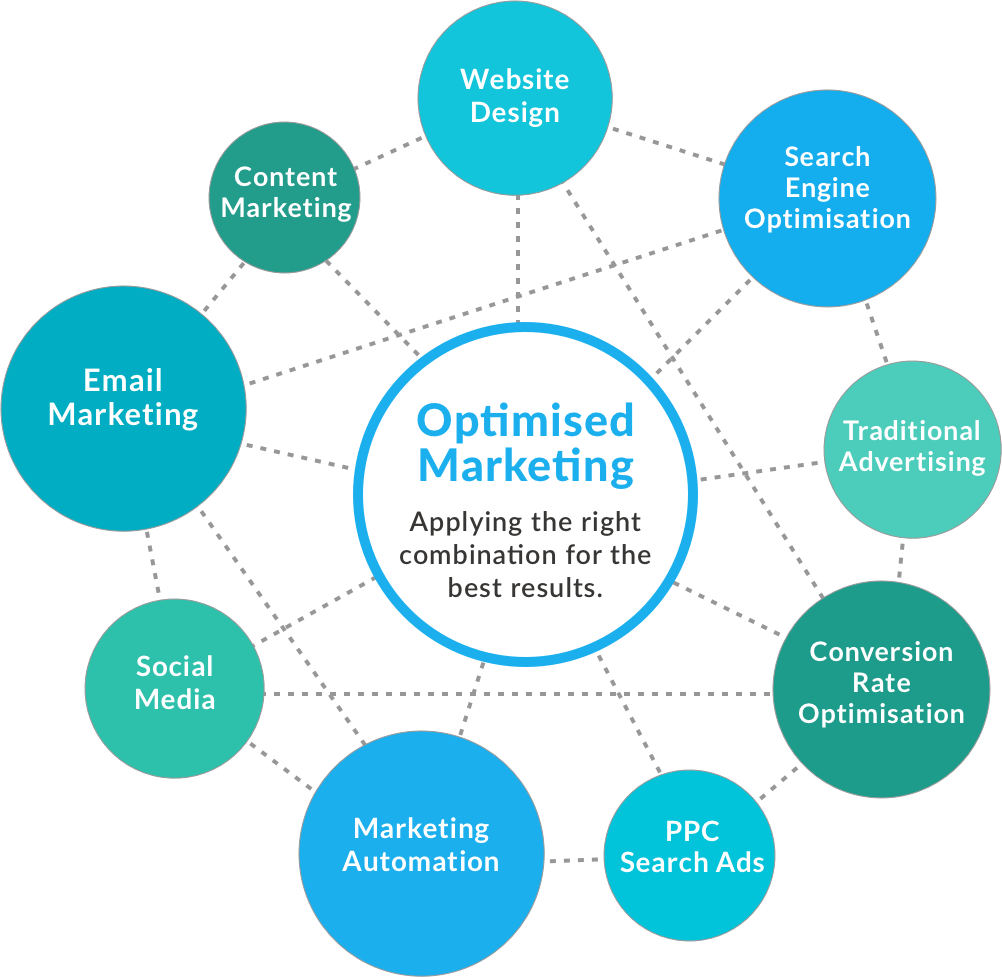A marketing plan shouldn’t be written and put on the shelf – that’s why we treat a client’s plan like a guidebook that continually focuses our actions and reminds us of the strategies we’re deploying to achieve your KPIs.
Our marketing process covers 11 crucial steps:
- Brand Mission
- Value Proposition
- Buyer Personas
- SWOT Analysis
- Competitor Analysis
- Marketing Budget
- Optimised Website
- Marketing Tools
- Strategy Grid
- Activity Calendar
- Goals & KPIs
We’ll guide a client through these steps and summarise the information utilising our planning templates. It’s a 2-way process where the client imparts valuable information to us and in turn we provide workshops and tools to facilitate the planning and ongoing activity:
#1. Describe Your Brand Mission
The first step in creating a strong marketing plan is to highlight the mission statement of your company. All of your marketing efforts will revolve around fulfilling that statement for your customers.
- What purpose does your company serve?
- What problems are you solving?
- Why are you in business?
- Summarise that mission in one or two sentences.
#2. Define the Value Proposition
There are many ways to go about developing a Value Proposition, but we think the following formula cuts to the chase. It’s also great for presenting the ideas to your team or visualising how the website page might convey this:
- Headline. What is the benefit you’re offering to customers, in 1 short sentence? Might mention the product and/or the customer. Does it grab attention – why should I care? What’s unique or desirable about it.
- Sub-headline or a 2-3 sentence paragraph. A specific explanation of what you do/offer, for whom and why is it useful. Why should I choose you rather than a competitor’s product.
- Bullet points. List 3-4 key benefits or features. Make sure the support the headline and your overall claim.
- Visual. Images communicate much faster than words. Show a hero shot or an image that reinforces your main message.
Evaluate your current value proposition by checking whether it answers these questions:
- What product or service is your company selling?
- What is the end-benefit of using it?
- Who is your target customer for this product or service?
- What makes your offering unique and different?
- Why would I purchase your product/service over the competitions?
Go beyond what you sell and focus on why it matters
to your customer
#3. Build Buyer Personas
Buyer Personas are semi-fictional profiles of your ideal customers derived from research and sales data from your existing customers. They define groups of our most important customers and consider demographics, behaviours, interests, and especially, goals and pain points; so that can align content and strategies with them throughout the buyer’s journey.
Match specific Persona’s to selected traffic sources and promotional hooks/lead-magnets and to certain stages within the Buyer’s Journey to personalise your messaging.
Write up your key Personas by downloading our Buyer Persona MS Word template.
#4. Conduct a SWOT Analysis
Identify Strengths, Weaknesses, Opportunities and Threats.
This bullet point table will focus us on the issues that need to be addressed for the coming year.
Use this information to address your marketing strategies.
To find your strengths answer questions like:
- What does our organisation do well?
- What are the things that other people say you do well?
- Why did we win our last pitch or why does Distributor X deal with us?
- What processes do we have in place that have made us effective?
- What do we currently do that is a unique strength to our business?
To find your weaknesses answer questions like:
- What could we improve in our organisation?
- What is causing a constant barrier to our success?
- What are we currently doing in our marketing process that could be improved?
- What are the things you need to avoid?
- What does our competitor do well that we don’t?
To analyse opportunities outside your business, answer the following:
- What external trends could bring opportunities?
- What are the current ongoing trends?
- What is the market missing? What disruptive thinking could you benefit from?
- What is changing in our industry that we could take advantage of right now?
Analyse the threats that may impede your success:
- What obstacles are you facing on your current mission?
- What are the negative aspects in the current market?
- What are our competitors doing better than us?
- Are there changes in our industry that could threaten our efforts?
- What political, economic, or social aspects could hinder our marketing efforts?
#5. Competitor Analysis
You don’t have to be the best business in the world – you just have to outperform your competitors.
- List key direct competitors in your market.
- Include global operators that you’d nominate as hero’s or as a source of inspiration.
- What are your competitor’s strengths and how can we negate or take advantage of them?
- Determine competitor vulnerabilities, and capitalise upon those weaknesses.
- What are they doing right and how could we improve on that?
Track your progress against your competitors based on industry reported sales, research, website rank tracking etc.
#6. Set a Marketing Budget
There are four ways you can set a marketing budget for the year:
- Percent of Revenue. This is where the revenue that your business brings in determines what your budget will be.
- Top-Down. This is where the GM or Marketing Manager decides what your marketing team will spend.
- Competition Matching. This type of budget is based on trying to reverse engineer what your competitors are doing.
- Goal Driven. This type of budget is based on the goals that you have set for the year. The amount you spend on each project will depend on the kind of goal you need to reach.
#7. Optimise Your Website
The website and the content within becomes the hub for all our marketing activity. And it’s crucial that your website gets the brand positioning, design and coding attention it deserves…
- It’s the place to deliver a clear and unique value proposition so your prospects and customers get what’s in it for them and why they should purchase from you. That proposition is usually delivered distinctly and quickly within key landing pages through copy and images but is also disseminated in overall website design, appealing to your Buyer Personas.
- An optimised website usually makes the development of landing pages, blog posts and lead capture forms a breeze. No doubt it will be built around a user-friendly Content Management System (CMS).
- An optimised website will be search engine optimised (SEO) to ensure keyword ranking on google and easily found by your targets. Intelligent use of keyword research will help optimise meta titles, meta descriptions, page headlines, copy and content and overall strategic direction of your site.
Your website is the centre for content distribution, lead capture, conversion and deal closure. And it’s a key starting point for attracting traffic and nurturing leads through our conversion processes. Don’t skimp on the investment required!
#8. Setup Marketing Tools
Whether you’re using a spreadsheet or something fancier, there is a plethora of tools and apps to help us plan, optimise, execute and track our research, activity and results.
A solid marketing strategy, backed by the right technology stack for your business, will help you stay on track to achieving your goals and may include:
The tools are there to help us do a job your competition probably haven’t even begun to think about. We’re going far beyond a monthly email newsletter – we’re strategically moving your traffic, leads and customers through an intelligent sales funnel – all within a level that matches your budget and resources, of course.
#9. Build out a Strategy Grid
Build out a Strategy Grid for your business defining your business/product strategies and tactics by buying stage; Attraction, Engagement, Conversion and Retention.

This is perhaps the most important element of your marketing plan because it assesses and details exactly what you’ll do with the resources that you have.
#10. Detail an Activity Planner
While the overall tools and strategies might be in place or documented, we still need to lay out what will happen next week or next month.
Dependent on your appropriate promotional cycle (weekly, monthly etc), you need to set up a planner to detail what email campaign will be delivered on the 15th or what promotion will run in June.
It could include a Content Publishing calendar or detail about what automation flow you’ll introduce in two month’s time.
While you should lay out a full 12 months of activity, it’s important to concentrate on the detail for the immediate rolling 3-4 months.
The activity planner can also include a list of strategic things-to-do with ideal delivery dates.

#11. Set Goals & KPIs
The last element in our marketing process is to set goals and key performance indicators. Our marketing goals should be S.M.A.R.T. This means they should be:
- Specific. You should know exactly what you’d like to accomplish.
- Measurable. If you can’t measure it, it’s not useful.
- Attainable. Stretch yourself, but avoid setting yourself up for failure.
- Relevant. Your marketing goals should be connected to clear business outcomes.
- Time-based. Give yourself a deadline by which you’ll achieve your goal.
Set up a spreadsheet for these goals and combine those results with reporting from sources like Google Analytics. Track them by your most appropriate promotional cycle (weekly, monthly etc). Common KPIs include:
- Revenue
- Gross profit %
- No. of online transactions
- Active Customers
- Website visitors
- Leads generated
- Conversion rates
- New Customers
Takeaways
While a strong marketing plan must cover at least these 11 elements, we’ve found that the more concise you can write this up, the better. It’s not that detailed reports and analysis are unimportant but when we’re summarising your plans and activity the shorter you keep it, the more understanding and buy-in you’ll have from key stakeholders.
If your first Marketing Plan draft covered these elements over 2-3 pages, you have already made a significant start to a strong plan and more than likely achieved significantly more well-contemplated planning than your competitors.

